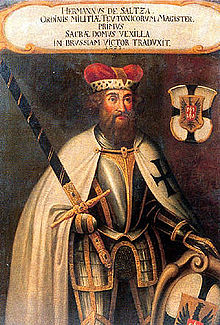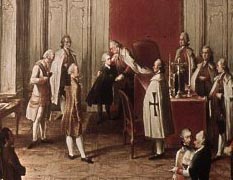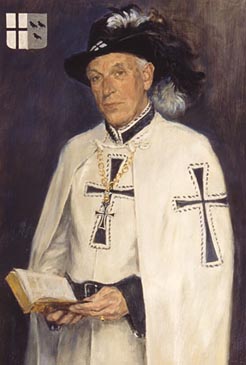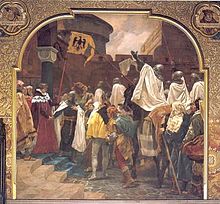|
|
The
Teutonic Order, more properly the Order of Brothers of the German
House of Saint Mary in Jerusalem, is an ancient order of knighthood
most associated with the Papacy and the Holy Roman Empire. Formed to
establish hospitals and aid pilgrims to the Holy Land, the order took
part in the Crusades throughout the Middle Ages. Due to the effects
of the Protestant Reformation, the Utrecht branch of the order
because protestant. However, the order as a whole is Roman Catholic
is nature and profession. Today in addition to the Protestant branch,
there exists the clerical Teutonic Order, which is more religious in
character, and the Imperial Teutonic Order, which is more chivalric
in character.
The Order
was instituted in 1190 by Duke Frederick of Swabia. After the capture
of Acre, the order received a permanent site in the city. The
following year, Pope Clement III confirmed this order in the Bull Quotiens
postulatur. The
order's mission was not limited to the Crusades and the Holy Land. In
1230, following the Golden Bull of Rimini, the Grand Master, Hermann
von Salza, and Duke Konrad I of Masovia launched what was known as
the Prussian Crusade. This was a joint invasion of Prussia intended
to Christianize the Baltic Old Prussians. The Order created the
independent "Monastic State of the Teutonic Knights,"
adding continuously to it as they conquered Prussia's lands. Also
added was conquered Livonia. The Order was accused by Polish Kings of
holding lands rightfully theirs. |
 |
|
 |
The
Teutonic order lost its main purpose of Christianization in Europe
following the Christianization of Lithuania. Thereafter the order
initiated numerous campaigns against its Christian neighbors, the
Kingdom of Poland, the Grand Duchy of Lithuania, and the Novgorod
Republic. The knights were economically powerful with a strong
financial foundation. They hired mercenaries from throughout Europe
to augment their forces and also became a naval power in their own
right in the Baltic Sea. Despite their strength, a Polish and
Lithuanian army decisively defeated the Order in 1140 in the Battle
of Grunwald. Following the 1515 marraige alliance between the Holy
Roman Emperor Maximilian I with Sigismund I of Poland-Lithuania, the
Holy Roman Empire no longer supported the order in its campaigns
against Poland. Following the hard times and losses experienced in
the 16th century, the Teutonic Order managed to keep its vast feudal
holdings in the Catholic areas of Germany. In 1809, however, Napoleon
Bonaparte ordered the dissolution of the Teutonic Knights, their
secular holdings being forfeit. Thereafter the order continued to
exist for the purpose of providing for the Austrian Archdukes and the
Holy Roman Emperor, and also as a means of service for its professed
religious knights and priests. |
Traditionally
the Teutonic Order had one class of knight, which had to prove
sixteen quarterings of exclusively German or Austrian nobility. This
was later relaxed to four quarterings for two hundred years. All
knights had to be practicing Roman Catholics. The knights were
considered to be religious, subject to the discipline of the Grand
Master. Following a reform in 1865, a division of Knights of Honor
was introduced for candidates who only were required to prove German
nobility in the paternal line. To enable the order to sustain itself
against the demands on its services, Archduke Wilhelm, introduced a
special category of Marian knights and dames by a decree in 1871.
These special Marian knights and dames were not considered full or
regular members of the Teutonic Order. However, they were entitled to
wear a variant of the Cross. Originally limited to Catholics of the
nobility of the Dual Monarchy, in 1880 membership was extended to
Catholics of any nationality.
|
The
Teutonic Order continued to receive Papal support. Pius IX, in the
1871 Bull Pia sodalitia, confirmed and upheld the ancient
statutes and new reforms of the order. In an 1886 Papal Brief, Leo
XIII gave his approval to several further reforms to the statutes
established by the Grand Master, approved by the Chapter-General, and
sanctioned by the Emperor. These reforms opened up all the dignities
and privileges of the Teutonic Order to those who had professed
simple vows, abolishing the category of solemn vows. Those who had
already undertaken the solemn vows, however, retained that obligation.
The latter
nineteenth and early twentieth centuries was a time in which the
Teutonic Order was active in Austrian life. School and hospitals were
under its care that served the local population. During the First
World War, the Teutonic Knights notably distinguished themselves.
Unfortuantely after the war, the new republican regimes were hostile
towards anything reminiscent of the Habsburgs. This created problems
and obstacles for the Teutonic Order. Furthermore, the rising threat
of communism and anti-Catholic sentiment were opposed to all noble
instituions and anything that could be considered noble. Indeed, this
situation threatened the very existence of the order. Though the
order was independent under Canon Law as an autonomy religious
institution, and therefore not in reality part of the Hapsburg
patrimony, the new republic was bent on revenge. The mere appearance
of association with the Habsburgs was sufficient. The properties of
the order, perceived by the new republican regimes as estates of the
Imperial House, were threatened with confiscation by the new
successor states. They wanted to remove every remaining association
with the Habsburg dynasty, and thus the order could not continue in
its old way. The last Habsburg Grand Master, Archduke Eugene, was now
forced into exile along with all the members of the Habsburg dynasty. |
 |
|
 |
The
Archduke offered his resignation to the Pope Pius XI in 1923. Before
this resignation became final, a Chapter-General selected Monsignor
Norbert Klein, a priest and Teutonic Knight as the new head of the
order. The republican government of Austria was now content to
consider that the order was above all a religious institution. In its
purely religious form, the order and its new Rule received Papal
sanction in 1929. The new order consists purely of priests and nuns
headed by the Grand Master, who is always a priest. Said Grand Master
holds the rank and precedence of Abbot. The Teutonic Order was
formally re-established in 2001 as a secular order, creating a
separate arm of the Imperial Teutonic Order from the Papal clerical
order. The religious order is currently headed by the Most Rev. Bruno
Platter. The secular order is currently headed by H.I.R.H. Prince
Karl Friedrich as Grand-and-German Master. The Imperial &
Patriarchal Confraternity of the Hospital of St. Mary of the Teutons
in Jerusalem is comprised of several divisions of the secular
Imperial Teutonic Order and is headed by H.I.R.H. Cardinal Count
Rutherford I, Imperial Patriarch as High-Commander. Also, the
Protestant Bailiwick of Utrecht remains to this day, perhaps
retaining more of the vestiges of the order than the clerical arm in
Rome, and is essentially an aristocratic society, headed by H.E.
Baron de Vos van Steenwijk as Land Commander. |
|